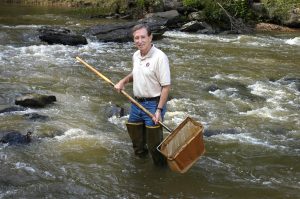
TUSCALOOSA, Ala. – Ask someone about the biggest threats to the Earth’s rivers – a primary source of drinking water for its inhabitants – and pollution is likely to come to mind, possibly followed by dams. However, a University of Alabama ecologist, who recently edited a 1,168-page comprehensive guide to North America’s rivers, says introduction of non-native species is a lesser discussed but real threat to our most valuable natural resource.
Dr. Arthur C. Benke, professor of biological sciences at UA and co-editor of the recently published “Rivers of North America,” said one of the goals in producing the reference book, detailing 218 of the continent’s rivers, was to promote the stewardship of our fresh waters.
“The primary motivation was to be able to describe the wonderful diversity that we have,” said Benke. “These are fantastic natural systems that are not only of value for their biodiversity, but they have great beauty, physical complexity, and fascinating histories. Because they all have their own story, the idea was to try and tell these stories.
“A part of every river’s story is how they have been treated by humans. So we wanted to cover not only what is great about these rivers, but what is not so great.” What’s not so great about them lies, of course, not within their natural features, but in what has been done to them.
“All human alterations of rivers, regardless of whether they provide services such as power or drinking water supply, result in degradation. The only exception is when we try to restore them.”
Various types of pollution, whether from industry, city sewage or agricultural run-off of sediments, fertilizer or pesticides, can, and does, harm rivers. The draining of swamps, buildings of dams and channelizing of rivers also upset the original balance, Benke said.
The Colorado River, as one example, once flowed at an average of 550 cubic meters per second, Benke said. Yet, today, because of dams and diversions, the river is often almost dry when it reaches the Gulf of California, its natural destination. The Chattahoochee River, which partially divides Alabama and Georgia, has 13 dams built upon it alone.
Although less cited as a threat to rivers, non-native fishes and other aquatic species, many of which prey on natural species, are upsetting the delicate balance. “We’ve introduced many non-native fish species, often on purpose, to improve the sports fisheries. As a result, many rivers contain a very high fraction of non-natives.”
Published by Elsevier/Academic Press, with a foreword by Robert F. Kennedy Jr., president of Waterkeeper Alliance, “Rivers of North America” provides readers with a single source of information on North America’s major river basins. Individual chapters are divided by geographic region, and are authored by some of the foremost specialists of those regions. Each chapter is produced in similar styles, making comparisons between rivers and river systems more practical. Within each chapter, three to five rivers are covered in detail, with others covered in one page summaries.
University of Alabama faculty Drs. Milton Ward, Phillip Harris and Amelia Ward authored the chapter entitled “Gulf Coast Rivers of the Southeastern United States.” Dr. Alexander Huryn, also a UA faculty member, co-authored the chapter on the nation’s Atlantic coast rivers of the Northeast. River basin maps were created by UA graduate students Angela Brink and Jennifer White, under the direction of Craig Remington, director of UA’s Cartographic Research Laboratory. Combined with almost 200 breathtaking photographs, the illustrations demonstrate the beauty and power of each river system.
Co-edited by Dr. Colbert Cushing, a retired river ecologist, the book lists for $99.95. More information is available at www.elsevier.com
Benke coordinated the graduate program in aquatic biology at UA for 14 years and has taught at the University since 1984. Prior to that, he taught at the Georgia Institute of Technology. He has published widely in scientific journals and books and has served on the editorial boards of the journals Ecology, Freshwater Biology and the Journal of North American Benthological Society, or NABS. He is also is a past president of NABS. He received his bachelor’s degree from Cornell University and his master’s and doctorate from the University of Georgia. Benke served on scientific advisory committees for American Rivers and the Kissimmee River Restoration Evaluation Program.
Some five years in the making, the book highlights a resource we can’t afford to take for granted, Benke said.
“Aside from the land we live on and the air we breathe, what’s more important than fresh water?”
Note: To request gratis copies for review or excerpt consideration, contact Allen.
Contact
Chris Bryant, Assistant Director of Media Relations, 205/348-8323, cbryant@ur.ua.eduSheri Dean Allen, Elsevier Press, 919/471-5628
Source
Dr. Arthur Benke, 205/348-1799, abenke@bama.ua.edu